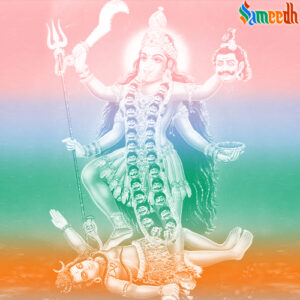Kali is a Hindu goddess who is associated with death, destruction, and the cycle of birth and rebirth.

Kali is a Hindu goddess who is associated with death, destruction, and the cycle of birth and rebirth. She is often depicted as a terrifying figure with a bloodthirsty nature, and is revered as a powerful and terrifying deity who is able to conquer any obstacle or challenge.
According to Hindu mythology, Kali is the consort of the god Shiva and is often depicted standing on top of Shiva, who is lying on the ground in a state of yogic trance. She is often depicted holding a sword or a trident, and is sometimes shown with a garland of skulls around her neck.
In Hinduism, Kali is often revered as a powerful and protective deity who is able to overcome any obstacle or challenge. She is also seen as a symbol of the impermanence of life and the cyclical nature of birth and death, and is often invoked in times of crisis or distress.
Battle with Shiv
In Hindu mythology, there is a story about a battle between the goddess Kali and the god Shiva. According to the story, Kali was a fierce and terrifying goddess who had a bloodthirsty nature and was known for her ability to conquer any obstacle or challenge.
One day, Kali became enraged and started to wreak havoc on the world, destroying everything in her path. The other gods became worried and appealed to Shiva, the god of destruction, to do something about Kali.
Shiva decided to confront Kali and put an end to her rampage. He challenged her to a battle, and the two of them engaged in a fierce and violent struggle.
During the battle, Kali became so enraged that she started to lose control of herself. Seeing this, Shiva decided to take drastic measures and lay down on the ground, entering into a state of yogic trance.
Kali, seeing that her opponent was not fighting back, decided to stop the battle and stepped on top of Shiva, calming down in the process. From this point on, Kali became a more peaceful and controlled deity, and she and Shiva became close allies.
Overall, this story illustrates the transformative power of yoga and meditation, and shows how even the most fearsome and terrifying deities can be brought under control through the practice of these spiritual disciplines.
Worship of Kali in Kolkata
In Calcutta (now known as Kolkata), Kali is an important deity and is revered by many people. Kali is the patron goddess of Calcutta and is often associated with the city.
Kali is widely worshipped in Calcutta and is considered to be a powerful and protective deity who is able to overcome any obstacle or challenge. She is also seen as a symbol of the impermanence of life and the cyclical nature of birth and death, and is often invoked in times of crisis or distress.
In Calcutta, there are many temples and shrines dedicated to Kali, and she is the focus of many festivals and celebrations. The Kali Puja, a festival that is held annually in honor of the goddess, is a major event in Calcutta and attracts thousands of devotees from all over the city.
Overall, Kali is an important figure in Calcutta and is widely revered as a powerful and protective deity who is able to overcome any obstacle or challenge. She is also seen as a symbol of the impermanence of life and the cyclical nature of birth and death, and is often invoked in times of crisis or distress.
Temples of Kali
There are many famous temples of Kali, the Hindu goddess who is associated with death, destruction, and the cycle of birth and rebirth, in India and around the world. Some of the most famous temples of Kali include:
Kalighat Temple: Located in Calcutta (now known as Kolkata), the Kalighat Temple is one of the most famous temples of Kali in India. The temple is dedicated to the goddess Kali and is an important place of worship for her devotees. According to Hindu mythology, the Kalighat Temple is believed to be one of the 51 Shakti Peethas, or sacred sites of the goddess Shakti. It is believed that the toes of the goddess Sati, the consort of Shiva, fell at this site, and the temple was built to honor her. The Kalighat Temple is known for its beautiful and ornate architecture, and is an important cultural and religious site in Calcutta. The temple is also home to a famous idol of Kali, which is made of black stone and is decorated with gold and precious jewels. The Kalighat Temple is an important place of worship for Kali devotees and is visited by thousands of people every year. It is also an important cultural and religious site in Calcutta, and is a popular tourist destination.
Dakshineswar Kali Temple: Located in Calcutta, the Dakshineswar Kali Temple is another famous temple of Kali in India. The temple is dedicated to the goddess Kali and is an important place of worship for her devotees.
Siddhivinayak Temple: Located in Mumbai, the Siddhivinayak Temple is a famous temple of Kali that is visited by thousands of devotees every year. The temple is dedicated to the goddess Kali and is an important place of worship for her devotees.
Tarapith Temple: Located in West Bengal, the Tarapith Temple is a famous temple of Kali that is visited by thousands of devotees every year. The temple is dedicated to the goddess Kali and is an important place of worship
Overall, Kali is an important figure in Hindu mythology and is revered as a powerful and terrifying deity who is associated with death, destruction, and the cycle of birth and rebirth.